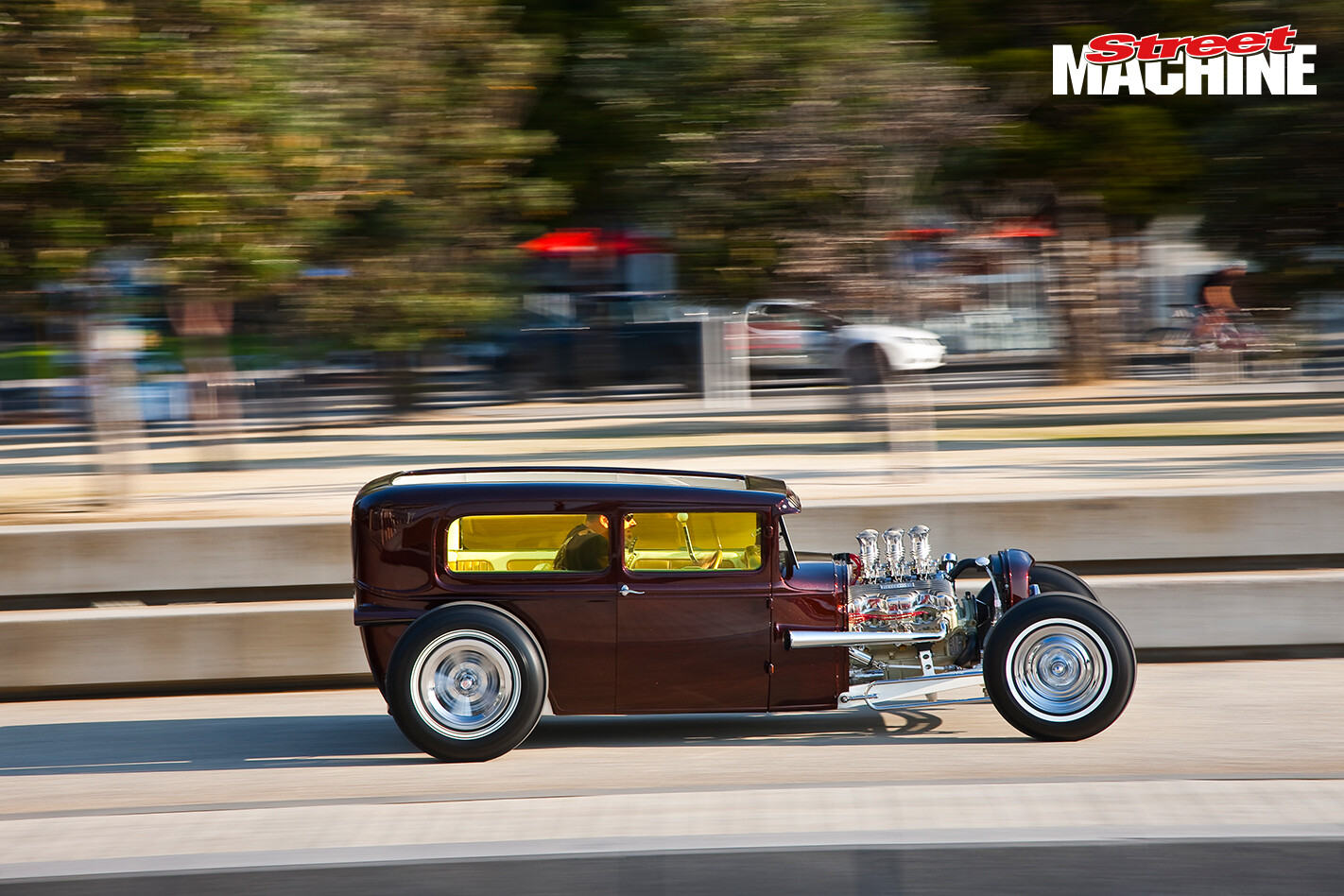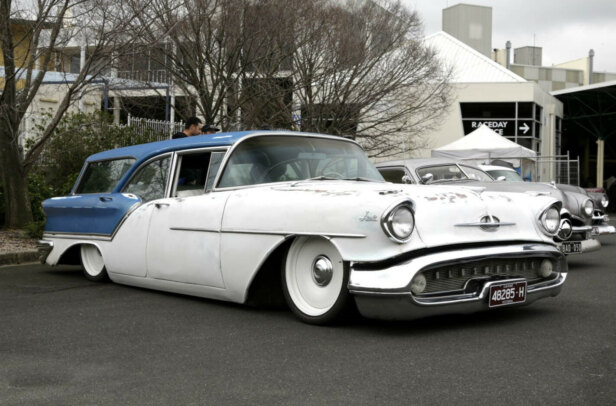TROY Trepanier once said: “When people go to a show, they generally only remember three cars; you want to be one of those three.” Well, Richard Dabbs certainly nailed that with his wild 1930 tudor, Brown Sugar. It was one of the most talked-about machines at Meguiar’s MotorEx Melbourne. Throughout the show, Facebook and Instagram were going crazy with images of this chopped and channelled throwback to another era. “It was pretty awesome to be amongst all these mega-dollar, high-end Superstars and it was my little A-model that I built in my garage that was attracting so much attention,” Richard says.
He may be unaccustomed to such interest, but Richard has plenty of builds to his credit, including a ’63 Thunderbird (Voodoo Bird); a gnarly, chopped, flat-black ’57 Caddy (LOCAD); a ’61 Caddy (Kandy Kad); a chopped ’54 Coupe de Ville; a ’61 Lincoln; and a few other neat Yankee projects, most of which were simple streeters. With 50s and 60s iron featuring so prominently in Richard’s automotive history, it begs the question: Why a hot rod? “I’m not a hot rodder,” declares Richard emphatically. “I like true 60s-era stuff; mismatching eras makes cars look clumsy. In my mind if a guy had built a high-impact show rod in 1960, this is what it would have looked like. This was the technology back then.”
Brown Sugar came about from a casual trip to good friend Greg Ford’s place. Greg was working on a Model A tudor, and as soon as Richard spied it he decided there and then: “I’ve got to have one of those.” He sold off the ’61 Lincoln he’d just finished slotting a 460 and C6 into, then put out the word. It just so happened that Keith Sutton (who had sold him the T-bird that became Voodoo Bird) had a suitable body on its way across the big pond.
“I trust Keith and he said it was good,” recalls Richard, “so I bought it sight unseen. The bottom of the cowl was rusted and the lower two inches of the doors had to be replaced as the metal had gone weak, however that was about it,” says Richard. “Mind you, if you saw the photo of it then and now, you’d say: ‘Really?’” First up, Greg Ford was commissioned to build a perimeter chassis. In-keeping with the 60s theme, it’s based on Model A rails with a drilled Super Bell I-beam and hairpins up front, combined with a triangulated, four-bar rear suspending a 60s Galaxie nine-inch out back.
Resettled in Richard’s garage, the entire floor was sliced out and the body set over the chassis at the desired height, with Richard scratch-building a new floor from there. He was also responsible for adding the crossmembers and spring perches, along with the mounts for the shocks, headlights, transmission and that gorgeously detailed 348ci Chevrolet W big-block. “I bought the W from Pete Townsend, because it’s different,” says Richard. “In 1960 it would have been the duck’s guts; it was only released in 1958 and still very new.”
Even the inlet manifold holding up the six repro Strombergs (costing 600 bucks a pop!) is a genuine 1960s Edelbrock piece. The only problem with the W big-block is it’s about four inches longer than a small-block Chev with a shorty water pump – so the firewall was chiselled out and recessed somewhat. Even then it was all a tight fit. “I love how the magneto comes up through the cowl,” Richard says. He pretty much flew solo with all the fabrication work and body mods, which include the neat swage line bordering the rear licence plate and the incorporation of ’49 rear tail-lights – all in steel. When it came time to slice a full four inches out of the roof, Greg Ford came over for the weekend to lend an experienced hand.
The dash was another instinct call by Richard. “In the 60s, the more mods you did, the more points you earned, so I knew I wanted to do something radical with the dash. I’d seen a couple of US rods with full car dashes, so I typed ‘50s dashboard’ into eBay. This ’56 Oldsmobile unit popped up, it was 100 bucks, so I pressed the ‘Buy Now’ button. When it arrived, I stripped it and started hacking.” It lost a few inches off either end, while a new finned centre section was specially cast and now houses three accessory gauges. According to Richard, with heaps of diecast parts, the Olds dash was an absolute prick to work with, however after lots of repairing, sanding and polishing, the finished ensemble looks like it was always meant to be there.
Although still very raw at this stage, Richard’s tudor had everything it needed to make it run and drive. “I took it to the 2010 Kustom Nationals; I wanted to make sure everything worked and everything cleared. I used up two tanks of fuel driving around Phillip Island. It was a lot of fun.” While in this raw state, Brown Sugar also picked up Best Unfinished at John’s Picnic. A few weeks after the Phillip Island outing, the car was back in a million pieces ready for final body, paint and trim. Ahron Jeffree from Rolling Art Coachworks helped out with a heap of hammer ’n’ dolly work, as well as adding the peak that now runs across the top of the grille shell. It was then off to Cam’s Metal & Speed to finalise the body ready for one of Brown Sugar’s most striking aspects – the paint.
“I had exactly this colour in mind from the very beginning,” says Richard. “I was confident if I threw enough chrome at it, it would work pretty well. I sat down with Mat Egan from Extreme Designs, who painted the car. Mat showed me some colour chips and we both picked it.” The final hue was achieved using House Of Kolor Root Beer Kandy over a HOK Galaxy Grey base. To make it pop, Mat mixed in some coarse flake (HOK Pale Gold Metajuls). “Although I wanted the flake to be obvious, I didn’t want it to look like a 70s ski boat, so having just the right amount of flake was very important. Mat is a talented motherfucker; he nailed it!”
After the paint had settled, Carmine De Maria from CAD Customs did the final flow coat of clear. The candy and flake didn’t stop there. The engine, drivetrain and dash were all done in gold flake, with George at Nostalgia Panel & Paint coating the chassis in traditional white. “Guys were even painting engines white back in the day,” says Richard. Another aspect that Richard had nutted out from very early on was the wheels. They’re deliberately mismatched. “It’s the early dragster influence,” says Richard. “Drag racing was huge in the 60s and the early front-engine dragsters and gassers always had different wheels front and back.”
The one aspect that wasn’t so well planned was the interior. Richard had a rough concept – nutso 60s show car – but he wasn’t 100 per cent sure of all the details. “Although I had final say, I totally left it up to Glenn French at Rocket Custom Auto Trim. I hadn’t worked with Glenn before, so it was a real arse-clenching moment. He did a really good job. It’s got everything – diamond pleats, tuck-and-roll, the lot. I wouldn’t change one detail.” The heavy-flake gold-and-white vinyl work really well together and they’re highlighted by the yellow-tinted Perspex windows. As for that crazy-tall shifter, it was hewn from a solid chunk of billet by good friend Jason Bonnicci from ToolTech.
 So what did Richard think of all the attention that Brown Sugar attracted? “Having older members of the hot rod community, plus a few of the established names in the sport, along with guys that I didn’t know come up and say ‘Wow!”, it made me feel pretty cool.” You couldn’t ask more of any build, which makes Brown Sugar an all-round winner!
So what did Richard think of all the attention that Brown Sugar attracted? “Having older members of the hot rod community, plus a few of the established names in the sport, along with guys that I didn’t know come up and say ‘Wow!”, it made me feel pretty cool.” You couldn’t ask more of any build, which makes Brown Sugar an all-round winner!




Comments